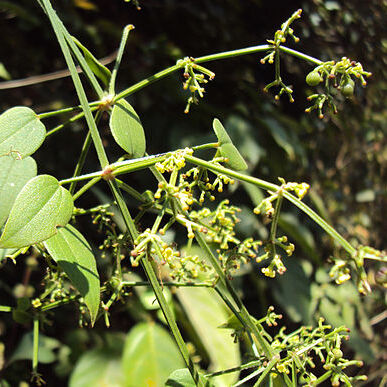Vines, herbaceous, climbing or scrambling herbs, with red rhizomatous base and roots; stems to 3.5 m, several to many from base, often much branched, quadrangular, glabrous to puberulent, with ribs rounded to thinly winged, sparsely to densely retrorsely aculeolate. Leaves in whorls of 4 or more (up to 8 or rarely 12); petiole (1-)1.5-3(-6) cm; blade drying papery to thickly papery, usually remaining ± greenish, lanceolate, oblong-lanceolate, ovate, or oblong-ovate, (1-)1.5-4(-7) × (0.3-)0.5-1.5(-2.5) cm, length/breadth index mostly 2.5-4, glabrous to pilosulous or hirtellous, sparsely to densely scaberulous, base rounded, truncate, cordulate, or cordate, margin serrulate-aculeolate, apex obtuse and apiculate to acute or acuminate; principal veins 3 or 5, palmate. Inflorescences thyrsoid, paniculate, with terminal and axillary, several-to many-flowered cymes; axes glabrous to puberulent or pilosulous, ± aculeolate; bracts linear-lanceolate to ligulate, 1-3 mm; pedicels 1-4 mm. Ovary 0.5-0.8 mm, smooth to scaberulous. Flowers hermaphroditic (rarely polygamo-dioecious?). Corolla pale yellow or greenish yellow, rotate, glabrous, fused base 0.2-0.4 mm; lobes lanceolate, spreading to reflexed, 1.2-1.5 mm, caudate. Mericarp berry becoming orange then apparently black, 4-6 mm in diam. Fl. Aug-Sep, fr. Oct-Nov.
A climber. It is a straggling plant. It grows 1-8 m long. It keeps gorwing from year to year. The stems are angled and have small hooks. The leaves occur as 4 in a ring. The leaves are often heart shaped at the base and are broadest just above the base. They narrow to a long tip. The leaves are 3 cm long by 1 cm wide. The flowers are small and greenish-yellow and on branched stalks at the ends of shoots or in the axils of leaves. The fruit are fleshy and black and divided into halves. The seeds are kidney shaped.
Scrambling or climbing, slender, perennial herb, reaching up to 1.5-5.0 m high; stems 4-ribbed, often with recurved prickles. Leaves and stipules similar; blades cordate; upper surface glabrous, margins and veins below with recurved prickles; petioles 15-60 mm long. Flowers in several-to many-flowered, axillary and terminal cymes. Corolla subcampanulate, greenish to yellow; lobes ± triangular, long-acuminate. Flowering time Jan.-May. Fruit dark purple to black, of 2 mericarps up to 3.9 mm in diam.

